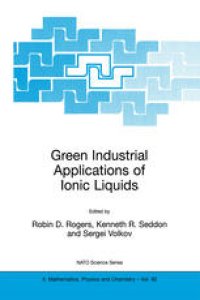
Ebook: Green Industrial Applications of Ionic Liquids
- Tags: Organic Chemistry, Physical Chemistry
- Series: NATO Science Series 92
- Year: 2002
- Publisher: Springer Netherlands
- Edition: 1
- Language: English
- pdf
This book contains the lecture notes for the NATO Advanced Research Workshop on th Green Industrial Applications of Ionic Liquids held April 12th_16 , 2000 in Heraklion, Crete, Greece. This was the fIrst international meeting devoted to research in the area of ionic liquids (salts with melting points below 100 0c), and was intended to explore the promise of ionic liquids as well as to set a research agenda for the fIeld. It was the fIrst international meeting dedicated to the study and application of ionic liquids as solvents, and forty-one scientists and engineers from academia, industry, and government research laboratories (as well as six industry observers and four student assistants) met to discuss the current and future status of the application of ionic liquids to new green industrial technologies. It was immediately clear that the number of organic chemists and engineers working in the fIeld needed to be increased. It was also clear that the declining interest in high temperature molten salts and subsequent increase in low melting ionic liquid solvents had not yet taken hold in Eastern Europe. Participants from NATO Partner Countries contributed signifIcant expertise in high temperature molten salts and were able to take back a new awareness and interest in ionic liquid solvents.
This book is entirely devoted to research in the area of ionic liquids, which are salts with melting points below 100°C. It explores the promise of ionic liquids and sets the research agenda for the field. With a distinct bias towards actual industrial R&D applications, the book is virtually a manifesto for the new age of Green Chemistry.
The major industrial challenges to sustainability - the book's leitmotiv - are: reducing water use; increasing energy efficiency; reducing reliance of fossil fuel feedstocks; increasing use of renewables; including sustainability as a major economic criterion. Thereafter, the book goes on to consider precisely where ionic liquids can help in achieving this new vision, via new techniques, new processes, new reactions. The Safety/Health/Environment properties of the ionic liquids are also considered. Finally, it is clear that there needs to be a major increase in the number of workers studying ionic liquids if this promise of a new Green Chemistry is to be achieved.